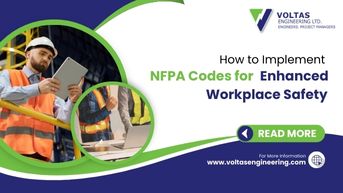Fire safety is not a luxury; it is a fundamental requirement for any business. A single fire incident can have devastating consequences, endangering lives, disrupting operations, and causing significant financial losses.
Safety and following the rules are essential for any business. The NFPA is a key player in creating guidelines that keep people and buildings safe. The National Fire Protection Association has established a comprehensive set of codes and standards. These codes provide a vital roadmap for businesses to create a safe and secure work environment. Following these codes demonstrates a commitment to the well-being of employees and the long-term success of the organization.
Significance of the NFPA

The NFPA is a global authority in fire prevention and safety, creating standards and norms embraced by governments all over the world. The NFPA was founded in 1896 and is now regarded as a major voice for fire safety and prevention, as well as the eradication of property damage, loss from fire, electrical damage, and related deaths and injuries. Through collaboration, the NFPA develops codes and standards for a variety of industries, like manufacturing, healthcare, and hospitality, involving experts, the general public, and practitioners.
Importance
Businesses may successfully navigate the complicated terrain of NFPA rules by realizing the value of compliance, locating applicable codes, performing risk assessments, and creating detailed plans. Respecting these guidelines guards against legal trouble and possible financial losses, in addition to guaranteeing the safety of staff and clients.
The NFPA Codes and standards have actual consequences that affect both safety and finances. These consequences may include legal repercussions, insurance implications, and significant harm to a company’s reputation.
To determine which NFPA codes and standards apply, depending on their industry and particular operations, many businesses must adhere to distinct NFPA codes.
The most popular NFPA codes that apply to various businesses are as follows:
1. NFPA 101 (Life Safety Code)
It aims to safeguard building inhabitants from fire and related hazards by defining minimum standards for building design, operation, and maintenance.
2. NFPA 70 (National Electrical Code)
It emphasizes electrical safety and addresses everything from the installation of wiring and equipment to the use of electrical systems in potentially dangerous areas.
3. NFPA 13 (Standard for Installation of Sprinkler Systems)
This specifies the requirement of an automatic sprinkler system crucial for controlling and putting out fires.
While these codes provide a strong foundation, it’s important to consider industry-specific guidelines as well. Many industries have additional regulations aimed at addressing unique fire hazards.

Risk Assessment
The NFPA encourages businesses to conduct thorough risk assessments to determine which NFPA codes and standards apply to their operations. It includes assessing the company’s electrical infrastructure, fire risks, and other safety-related issues. Businesses can perform comprehensive risk assessments using step-by-step instructions provided by NFPA codes and standards.
✔️ Determine potential fire hazards specific to the industry.
✔️ Analyze how successful the current fire safety measures are.
✔️ Assess how a fire may affect people, property, and business operations.
✔️ Also consider external factors such as the accessibility of emergency services.
Creating a Compliance Plan
Organizations should design a strong compliance plan by assigning responsibility for compliance management, conducting regular audits, and staying updated on the latest NFPA code and standard versions.
The process of creating a compliance plan:
-> Assigning Responsibility
Assign individuals or teams to supervise compliance. This involves a safety officer or a compliance manager.
-> Frequent Audits
Emphasize how crucial it is to carry out frequent audits to identify and address any deviation from NFPA codes.
-> Keeping Up-to-date
Encourage companies to sign up for NFPA newsletters and to visit the website frequently for updates. Stress the importance of attending pertinent workshops or conferences.
Employee Training and Awareness
Programs for employee training and awareness are emphasized by the NFPA. Make sure that staff members know fire safety protocols, evacuation procedures, and other relevant aspects outlined by NFPA codes and standards. The NFPA goes into further detail about why continuous training programs are essential.
>> Fire Safety Protocols
Make sure that staff members are aware of fire safety procedures, which include using firefighting equipment correctly.
>> Evacuation Procedures
Conduct frequent drills to acquaint employees with evacuation procedures, meeting points, and emergency exits.
It is advised to work with fire protection professionals and electrical engineers for complex compliance issues. These experts can advise on particular code requirements and assist in putting the necessary adjustments into practice.
NFPA Professional Advice
It is advisable to collaborate with trained fire protection professionals who possess the ability to evaluate existing protocols and provide enhancements.
1. Electrical Engineers
Consulting with electrical engineers helps guarantee NFPA 70 compliance when working with electrical systems.
2. Adapting to Revisions
NFPA codes and standards are regularly updated to improve safety technology and practices. Businesses must be vigilant and adapt to these revisions to maintain compliance. Advise on how to stay informed about code changes and seamlessly integrate them into existing safety procedures with ease.
3. Adapting Code Revisions
Offers advice on keeping up with modifications to the code.
4. Check NFPA Updates Regularly
This stresses the importance of frequently checking for updates for recent code revisions.
5. Training Programs
Incorporate training programs to educate employees about changes to NFPA codes and standards and how these changes impact daily operations.
Encourage businesses to view compliance with NFPA codes and standards not just as a regulatory obligation but as a crucial part of their commitment to the well-being of their staff members and community. An active approach to NFPA compliance is not only a legal requirement but also a strategic investment in the longevity and success of the business.
Following NFPA codes is a critical first step, but true fire safety goes beyond mere compliance. By fostering a culture of safety in your workplace, you empower employees to identify and address potential hazards, participate actively in drills, and act decisively in an emergency. This commitment to safety not only creates a more positive work environment but also demonstrates your dedication to the well-being of your employees—the heart and soul of any successful business.
Additionally, a proactive approach to fire safety can yield significant financial benefits. By reducing the risk of fires and injuries, you can avoid costly fines, legal issues, and property damage. Strong safety records can also lead to lower insurance premiums.


